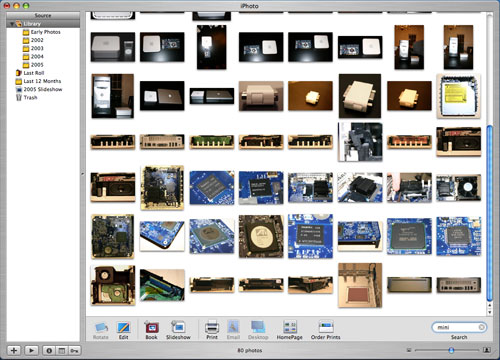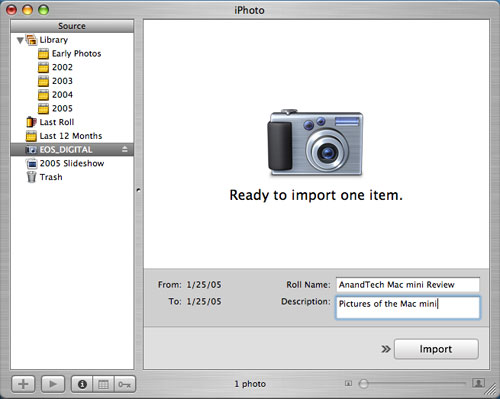Apple's Mac mini - Tempting PC Users Everywhere
by Anand Lal Shimpi on January 25, 2005 7:39 AM EST- Posted in
- Mac
iPhoto 5
For the most part, I detest photo management applications. They are usually riddled with cumbersome interfaces and/or lack any sort of real editing power. I tried using iPhoto 4, which was a part of the iLife '04 suite, and I was left fairly disappointed. I had to switch between editing and organizing modes to edit or just flip through my pictures. Images took entirely too long to flip through and despite the fact that iPhoto had the best interface of any photo management application that I'd used, it was still not enough. In the end, it was just like everything else to me and I happily continued using Photoshop for editing and saving pictures for AnandTech articles. I used folders to organize the pictures according to article, so I didn't need the organizational aspects of iPhoto for that. But then came iPhoto 5 - time to give it another try, but this time, it looked like there was hope.
During his keynote at Mac World San Franciso, Steve Jobs talked about iPhoto 5 as the only application that you'd need for both editing and organizing your photos. For my uses, Photoshop is basically overkill, but I've never found anything to suit my needs better without sacrificing usability in one way or another. But with a better interface and a new editing dashboard, iPhoto 5 seemed promising.

The iPhoto 5 interface has been greatly simplified. No longer are there different modes to switch between, everything happens in the same browsing mode. You get photos into iPhoto using its import feature, which is activated automatically whenever you connect a digital camera or a removable disk (a configurable option).
Thankfully, iPhoto gives you the option of deleting your photos automatically from the media/camera after it is done importing them. Once you confirm your intentions, iPhoto goes off and copies all of the photos into your iPhoto Library. Your photo library can be viewed at variable sized thumbnails, adjustable by a slider in the lower right of the application. The scaling of the number of pictures on your screen at one time happens very quickly as iPhoto will render the thumbnails quickly, and then later, sharpen the images once you're done playing with the slider. iPhoto is much faster (especially on the G5) now, and photos no longer take a little bit of time to come into focus when browsing through them one at a time (as opposed to a page of thumbnails). Also, when browsing quickly, they will appear as thumbnails rather than blurry images (more useful in my opinion).
The iPhoto Library is organized by year and feeds off of the information written by your camera to the images. If you have a lot of photos, the Library quickly becomes cluttered, since it is organized by nothing more than date. This is where some of the indexing features of iPhoto come into play, but they do require a bit of user intervention.

When you import images into the Library, you have the option of tagging the images that you import with a title. For example, when I imported the images for this review, I titled them "Mac mini". Now, even if I have thousands of images taken in 2005, I just type in "mini" in the search box and all my Mac mini images come up instantly, thanks to a fully indexed search in iPhoto. Now, titling images isn't something that I'd normally take the time to do, but the way iPhoto works is that you just create one general title and it will apply it to all of the photos that you're importing (or you can selectively import them).

After they are imported, you can go back and add ratings, keywords and comments to photos on an individual basis, all of which are fully searchable fields. You also have the option of populating these fields after the fact using iPhoto's batch processing. Just highlight what photos you want and you can add a title, comments or even modify the date/time. And if you actually take the time to make good use of these searchable fields, or even if you just make use of the batch titling upon import, you can create Smart Albums based on searches of these fields. For example, you can create an album of all pictures of "video cards" or "cars I'd like to buy" or just about any other combination that you can think of.
Personally, I'm not enough of a photo enthusiast to put that much time into my digital library, but if you have a habit of taking a lot of pictures, iPhoto 5 offers some very excellent and intuitive ways of organizing them. Plus, the interface works and feels just like the rest of OS X, which is a very strong point of iPhoto. There is one exception to my last statement, however. Hitting Command + W will actually exit the iPhoto program itself, something which breaks the way that almost all OS X applications work. One thing that I was a fan of with OS X is the consistency with which all applications behaved, and iPhoto unfortunately breaks that consistency - not something I was too happy with.










198 Comments
View All Comments
bob661 - Tuesday, January 25, 2005 - link
#4The Mac mini isn't just targeted at Mac users that's why there is a comparison with Dell. There WILL be PC users that buy this thing and at $499 people primarily at price. The $499 crowd IS NOT the techie, computer-savvy group. Most of our arguments for buying computers don't apply.
mickyb - Tuesday, January 25, 2005 - link
I would wait for the turbo mini. It sounds like it needs a faster drive and better video.Aileur - Tuesday, January 25, 2005 - link
A thought comes to mind.Could apple get sued by other online music stores because osx comes with itunes preinstalled? Isnt that kind of like microsoft ie/windows?
Oh and, i want a mac mini. I bought an ibook g3 800 a couple of months ago, on an impulse to actually try out osx. Sold my toshiba 2410 1.8GHZ (p4 not pm) and let me tell you, ive been advocating macs ever since. I believe if you're everything but a gamer, a mac is a great buy.
On this note, let the whining begin.
downtowncb - Tuesday, January 25, 2005 - link
I'll never understand why people insist on comparing the Mac mini to Windows based systems from a hardware standpoint. Getting a "more powerful" CPU from a similarly priced Dell doesn't matter to the target demographic of the Mac mini. I can tell you that neither Grandma Claire nor Joe iPod-owning-college-student can tell you the speed of their hard drive and probably couldn't tell you three things about their graphics processor either. They both want a computer that works and won't break. The hardware is actually quite trivial to most of the users of this machine. Enthusiasts know they aren't buying a high-end machine, and the others don't know and/or don't care.bob661 - Tuesday, January 25, 2005 - link
Good article. Why?3) To the user that this type of computer is targeted at, do either numbers 1 or 2 matter? The answer is no, all that matters is price and whether or not the thing works. If that statement weren't true then you would never hear the phrase "I've had my computer for 5 years, I need a new one", instead everyone would be a performance fanatic like the rest of us and upgrade every year at worst.
jtntwozz - Tuesday, January 25, 2005 - link
no.1 what are u talking about?!?!?nice article.. i love all 3 of ur mac articles..
Dranzerk - Tuesday, January 25, 2005 - link
I'll wait till you can find half a million on Ebay for $200 fully upgraded in a few months..thats the sweet spot when people say "Why did I buy this!".JacobAppler - Thursday, September 2, 2010 - link
You can also save some real money on the Mac Minis by shopping safely. Go to a comparison site like Apple Sliced.com and you won't need to worry about your Mac Mini costing too much.The Mac Mini can be the redheaded stepchild of Macintosh land, but it's worth looking at.